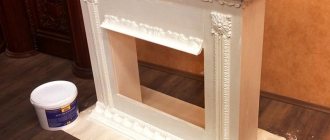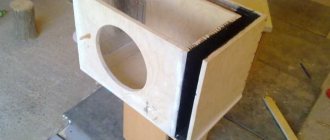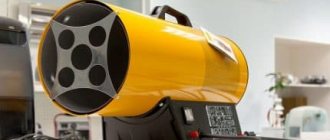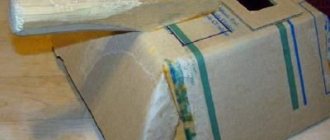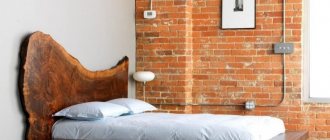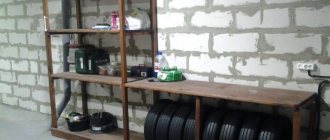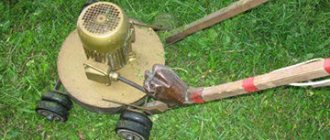Home » Building a house » Do it yourself
Alexander Korovaev 04/30/2020
4642 Views
Components for it can be purchased at any specialized store. The principle of assembling such products is simple - the main thing is to strictly follow the instructions. So, we’ll tell you in detail how to make doors for a wardrobe with your own hands.
Guides for sliding doors
As you understand, the sash is not everything. Guides are needed along which these very doors will move. There are two of them - upper and lower. In appearance they differ significantly.
The top guide for the wardrobe door The bottom guide is made of metal
When installing the door, first insert it tightly into the upper guide, lift the sash all the way and place the lower rollers in the corresponding slot. The entire structure is shown in the following photo.
Assembly diagram
Selecting a location
It’s great if there is a niche in the room where you plan to install the cabinet - in this case, all you have to do is assemble a “stuffed” cabinet, attach shelves and hangers to the walls of the niche, and also install sliding doors; in this case, the back and side walls will be absent. If you don't have one, you can build a corner cabinet or simply attach it to the wall of your choice. Keep in mind that once assembled, this structure will be stationary and you will not be able to move it, so choose the location of your cabinet carefully.
Then get to designing. Start by measuring your future cabinet with a tape measure. Measure several times and write down the desired height, length and width of the cabinet on a piece of paper. This information will be useful when purchasing materials. Make a scale drawing and mark on it all the necessary additions that you plan to place in your closet.
These can be shelves, drawers, baskets, lofts, hangers, etc. It’s not so difficult to draw a wardrobe yourself, the main thing is to conscientiously approach its measurement, take into account the scale when drawing up the drawing, and pay attention to every little detail.
The length of the cabinet should not exceed 3 meters, the maximum length is 5 meters. The length of each door should not exceed one meter. This is directly related to the load on the “rails” of the cabinet and the structure as a whole.
Perform a full calculation of the materials required for your individual project. Double check and recalculate several times. Remember the golden rule: measure twice, cut once. It will be very unpleasant if you have to redo something during construction.
Accessories
Everything related to the facade has already been ordered, but for the interior design of the cabinet you need to purchase furniture fittings. For our project you need to buy:
- For fastening hardboard using self-tapping screws or nails.
- In the middle compartment of the cabinet, to adjust the height of the shelves, you need shelf rests.
- Confirmations dimensions 70x5 mm.
- Rod holders.
- Self-tapping screws measuring 16x4 mm.
- Two rods for hangers measuring 775 mm.
Cutting lumber for a chest of drawers in the bedroom
I unravel and trim the panels on a tabletop sawing machine. Since the wood is soft and quite resinous, I use a disc with not a very large number of teeth. This disc went to the saw, although it was for construction purposes, the quality of the cut was good! The disadvantage will be the large width of the tooth.
The main problem with conifers is that they leave resin and carbon deposits on the teeth. If they are not washed, the sharpness and quality of the cut will seriously suffer.
To create supports for the chest of drawers, I beveled (sawed at 45 degrees) a furniture panel, 28 mm thick, and cut off the corners using a miter gauge:
Very wide workpieces cannot be trimmed on a table saw without extensions and without a large pendulum saw with a broach. I'll use a plunge-cut saw with a guide bar. I put a mark on one side and align the tire using this mark and a square. The tire must be secured, because the contact area between the tire and the board is small. It is very likely that there will be displacement without fixation.
To minimize chipping, the saw tooth should not protrude too much under the workpiece. An excellent option if the saw protrudes the length of a tooth.
Thanks to this setting, the tooth will work along the entire length and cut the fibers instead of tearing them.
It would be great to use an MDF or plywood backing. This will allow dust removal to work as efficiently as possible.
Sample of the simplest cabinet
Let's take a simple closet as an example, consisting of 2 sections, one of which will contain shelves, and the second will be intended for outerwear. This type of cabinet does not have side and back walls, bottom and lid. We will install the cabinet in a ready-made opening, which is not uncommon in Soviet-style apartments. This cabinet option is the cheapest, because... the cabinet consists of a minimum number of parts and does not contain drawers. Internal parts can be made from the cheapest material, such as white chipboard. As the end edge, you can use a paper-based tape with glue applied to it, which is glued with a simple household iron or C-profile.
I prefer not to skimp on material and use the main color chosen by the customer. As a result, the price does not vary enough to become anyone's problem. I use PVC edge as the end edge.
Manufacturing
The step-by-step scheme for making any chest of drawers includes a number of stages. The main ones are: cutting and processing of parts, frame assembly, installation of partitions and drawers. Secondary: attaching handles, decorating. Each of the points must be performed in accordance with the rules, then the product will turn out to be of truly high quality.
Material cutting
Cutting chipboard and similar sheet panels can be done on your own or using special machines. Professional cutting services are offered by distributors of tile building materials and furniture manufacturers. When choosing this option, the cost of a homemade chest of drawers will increase slightly, but the ends of the sawn elements will be more accurate.
Choosing a chest of drawers for the bedroom, reviewing models, studying characteristics
When cutting chipboard yourself, you should remember the need for 1–2 mm of margin on the edge. In such cases, the jigsaw must be electric, the support of the sheets must be stable and level, and the furniture maker’s movements must be smooth and precise. The stage ends with checking the model, adjusting the parts and drilling holes for the confirmations using a drill 0.5 mm smaller.
Edge processing
At this stage, the ends of the parts are carefully inspected for defects and covered with self-adhesive edges. Step-by-step actions:
- Chips and similar irregularities are covered with wax.
- When planning to use the chest of drawers in conditions of high humidity, the ends are coated with sealant.
- After eliminating possible defects, the ends are covered with a protective film, heated with a hairdryer or iron.
The edge is heated in small sections, carefully pressed and ironed, the excess is cut off with a stationery knife.
Frame assembly
Any model of a chest of drawers is assembled with your own hands according to the general principle:
- In pre-marked areas, drill holes for screws of slightly smaller diameter.
- The parts are joined and connected with confirmations using a screwdriver.
- To check possible deviations, a square is applied to the corners of the assembled structure.
- Directly during assembly, lines are marked on the side parts for attaching the guides, starting from the bottom, with a mandatory 3 mm gap between adjacent drawers.
Beginners should choose a chest of drawers with drawers of the same height. In such models, the distances between the axes of the guides are completely symmetrical; checking the correctness of their location is not difficult.
Installing the table top and bottom
The assembly of any product begins from the bottom, with sequential fastening of the sidewalls and transverse shelves (if any). And only then, after checking the angles of the structure and marking the guides, the tabletop is screwed to the chest of drawers. There are no problems when working with simple, flat surfaces. The upper part is attached using confirmations and plastic furniture corners from the inside. Any additional elements of the chest of drawers (shelves, folding table) are fixed at the end, after checking the stability and correct assembly of the entire structure.
Attaching legs or wheels
Cabinet furniture made from lightweight board materials in most cases does not need legs. Problems with joining the walls are solved using a recess at the bottom of the chest of drawers on the reverse side. But it is advisable to equip heavy, frequently moved or stylish models with supports, thrust bearings or wheels. Such elements are screwed at a distance of at least 50 mm from the corners, at an equal distance from each other. The method of fastening depends on the type of leg and is specified before assembling the chest of drawers. In some cases, corresponding holes are pre-drilled in the bottom.
Rear wall installation
The back part is fixed with confirmats and finally strengthens the structure. Not only the corners, but also the diagonals of all the main elements of the chest of drawers must be checked. Deviations from the specified sketch of more than 1 mm are not allowed. The part is screwed in the absence or after elimination of any defects.
Characteristics of modern chests of drawers, current shapes, colors
Assembly and installation of boxes
This stage begins with assembling the boxes:
- The side parts are connected first and only then, after checking the diagonals and angles, the bottom is attached to the boxes with self-tapping screws.
- The second part of the guides is mounted to the sides.
- The pull-out elements are sequentially (starting from the bottom) inserted into the chest of drawers, pulled out and pushed in. Correctly assembled and installed boxes move smoothly, without displacement.
The given instructions allow you to make your own chest of drawers both from chipboard and from any board materials, including plywood or solid wood. The difference when working with denser varieties appears insignificantly, namely in the grinding of the ends and the use of more reliable fasteners. It is also necessary to remember that when assembling a chest of drawers on confirmed mats, there is no need to coat the joints; when using tongue-and-groove elements or mounting on dowels, the opposite is true.
Preparing for assembly
Once the finished parts have been delivered, you can begin preparing them for assembly. You will need an iron for this work. Carefully attach the purchased edge to the end of the part so that the beautiful side is on top. Carefully walk over it with a heated iron. Make sure the iron is not on steam mode.
Press the heated edge well and wipe thoroughly. Carefully sand the cut edges with sandpaper. There is no need to rush when preparing parts. Try to achieve the highest quality of work so that your wardrobe looks neat and beautiful.
From the base parts, assemble the base of the podium for the bottom of the cabinet. The base must be present.
